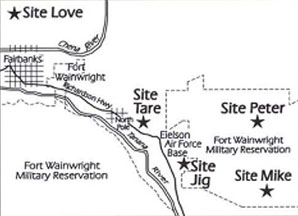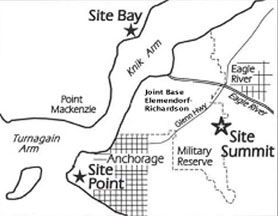Overview of the Alaska Nike Missile Sites
The Nike Hercules air defense system was a nationwide ground-based anti-aircraft system established to protect the United States during the Cold War. Guided nuclear missiles were used to seek and destroy incoming aircraft, such as nuclear armed Soviet bombers. The Nike sites were part of a larger air defense system that included the Aircraft Control and Warning System (AC&W), which was the first ground-based radar detection system constructed in 1951-1954(1), and the Distant Early Warning (DEW) Line, which was installed in more northern parts of Alaska from 1955-1957 and was more reliable and comprehensive. The White Alice Communications Systems (WACS) constructed from 1955-1959 used microwave transmissions to provide communications between these various facilities. The Nike Hercules missiles could deliver a 40 kiloton nuclear warhead to a target 100 miles away and with their surface-to-surface mission were considered the most accurate artillery weapon in the Army’s arsenal at the time.(2)
Eight Nike Hercules Missile sites operated in Alaska from 1959-1979. There were five sites in the Fairbanks defense area and three in the Anchorage defense area. The missile sites were organized under two battalions and were part of the 87th Artillery Group headquartered at Fort Richardson and under the command of the United States Army Alaska. The firing batteries were under the tactical control of the Army Air Defense Command Post (AADCP)
Alaska Nike Sites by Name and Battery:(3)
Fairbanks:
 Site Tare (A Battery A/2/562)
Site Tare (A Battery A/2/562)
Site Peter (B Battery B/2/562)
Site Mike (C Battery C/2/562)
Site Jig (D Battery D/2/562) (Also AADCP)(4)
Site Love (E Battery E/2/562)
Anchorage:
 Site Point (A Battery A/4/43) (Also AADCP and dual launching site)
Site Point (A Battery A/4/43) (Also AADCP and dual launching site)
Site Summit (B Battery B/4/43)
Site Bay (C Battery C/4/43)
The systems were organized into defense area that contained firing sites. The firing sites were also called batteries. Each battery had acquisition and tracking radars that identified and tracked incoming enemy airplanes, a computer to guide a missile to its target, and two missile launch structures.(5) One part of the site was known as the Integrated Fire Control area (IFC) where the Battery Control building containing the communications and radar equipment, command center, and the common living facilities were located. The computer was located in a radar control van that was parked inside the mechanical area of the Battery Control Building. The missiles were stored and launched from a second secured area, known as the Missile Launch Area that contained the missile launch and storage facility, the warhead magazine, and the Launch Control Building. The dog kennels were also located in the launch area, which was patrolled by sentries and guard dogs. Given the difficult weather and terrain conditions, the Nike Hercules sites in Alaska were configured somewhat differently than sites in the rest of the United States. The Alaskan missiles were stored in above-ground reinforced concrete bunkers, instead of in underground storage magazines. The tracking radars were on top of radar towers and were enclosed in steel “clamshells” to protect the radar from inclement weather.
If an enemy target was spotted, the tracking radar locked onto the target and sent information about the enemy airplane to the computer and the missile. When they wanted to fire the missile, the Battery Control Officer commanded the Launch Control Officer to push the "fire" button. The radars and computer kept the missile on target once it was launched. The missile warhead exploded on command from the computer when the missile got close to its target.
A Nike facility needed about 125 soldiers to operate it, and was staffed 24 hours a day, seven days a week. Most of the sites only had space for 50 people to live there, so some soldiers drove to and from the site each day. For security reasons, the enlisted men only knew their specific job and the men did not discuss their duties with each other or their families.
The rules of engagement to be followed by battery control officers at the Nike sites were very strict. No one was allowed in the launcher area alone (two man rule). The order to release a nuclear weapon had to be confirmed by two individuals, a commissioned officer on one team and a warrant officer or senior non-commissioned officer on another team, who would open a safe where each only knew half the combination. Release authorization was then confirmed by top secret code. Not all of the sites were in readiness position at all times. On a weekly basis, they rotated “Hot” status, meaning being ready to fire in fifteen minutes. When in “Hot” status, crews would live and sleep at their stations in order to be ready to go at a moment’s notice. The other batteries served as backup in case they were needed.
The missile sites conducted annual practice of their systems to evaluate the training and readiness of the crews, which in some cases early on included a live missile firing. Live missile firing tests did occur at Site Summit in the early 1960s, but as Anchorage grew these firings were moved to Site Peter outside of Fairbanks where there was a large uninhabited firing range.
As the Cold War subsided, the military budget was affected by the Vietnam War, and technology advanced to develop new defense systems, the Nike Hercules Missile sites became obsolete and were shut down. The Fairbanks batteries were closed in 1970 and 1971. Site Summit near Anchorage was the last Alaskan site deactivated and was closed in July 1979. The Army never used Alaska’s Nike missiles against a Soviet attack.
For more information on the Nike Missile Sites in Alaska:
Bob Raichle. “Alaska’s Cold War Nuclear Shield,” 2012.
National Park Service, "Alaska's Site Summit: Cold War Defense and its Legacy in the North"
____________________________________________________________________________
1 History of the Aircraft Control and Warning System in Alaska: Air Defense of Arctic Skies. By Argonne National Laboratory, Argonne Illinois, 2002. Prepared for the United States Air Force, Pacific Air Forces, Joint Base Elmendorf Richardson, Alaska. Edited/updated in 2013 by the Center for Environmental Management of Military Lands, Fort Collins, Colorado.
2 Raichle, Bob. “Alaska’s Cold War Nuclear Shield,” 2012: 9.
3 Thanks to Roger Babler for providing this information.
4 AADCP (pronounced “ad’cap”) is an acronym that stands for Army Air Defense Command Post. The purpose of the ADDCP is to provide command and control of the air defense artillery (ADA) fire units assigned to it. This involves coordinating the defense by assigning individual targets to the fire units. Other duties include serving as a communications center for disseminating and deciphering encrypted messages between higher command echelons and the batteries, and coordinating with the Air Force and NORAD (North American Aerospace Defense Command) assets.
5 Site Point near Anchorage was a dual launching site so it had four launch structures.

